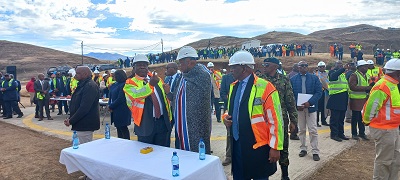By Thoboloko Ntšonyane
MASERU – His Majesty King Letsie III and South Africa’s (SA) President Cyril Ramaphosa officiate the groundbreaking ceremony for the Polihali Water Project, a key component of Phase II of the Lesotho Highlands Water Project (LHWP-II) at Malingoaneng, Mokhotlong.
Speaking at the sod-turning ceremony, King Letsie III said the ceremony represents warm relations between the two States.
“With this visit and with today’s event, we are taking an important step in the implementation of the treaty of LHWP…,” he said.
This project has created partnership between the two neighbors and Lesotho has been able to generate electricity and enjoy royalties while SA receives water.
He said the leadership of two countries ought to traverse this journey in order for the citizens of the two countries to accrue the benefits from this project.
The King urged the members of the community to support this project.
He also urged affected communities to religiously attend meetings, which are meant to address the issues affecting them.
He thanked the President and SA citizens for this “important flagship” assuring him that if properly implemented it will be a sign of economic growth of the two nations.
His Majesty reiterated that the citizens of the two nations should reap the tangible rewards through this project.
The SA President said the groundbreaking ceremony marked history between the two neighbors.
“I have seen the gold of Lesotho, the gold which is water and I hope they will not run out,” he said.
“As Basotho and South Africa we share deep connections of history, culture, and custom,” he said.
Ramaphosa said this water project is the biggest investment.
He said SA will raise to the tune of R40 billion (M40 billion).
The SA President pointed out that it has been critical for all communities affected by the project to be relocated and compensated.
He said that Lesotho is a beacon of hope, symbol of progress and the testament to the bilateral relations between Lesotho and SA. He said it should always be enhanced.
The sod-turning event is preceded by a Ministerial Meeting on Water and Energy of both countries which was held on Monday this week.
Polihali Water Project is currently being constructed in Mokhotlong.
SA Minister of Water and Sanitation Hon Senzo Mchunu said delay of the construction is regrettable as it has resulted in the escalation of costs.
On delays happening due to said when they approach the communities they make undertakings which he said must be fulfilled.
“We must reciprocate their kindness by fulfilling our mandate. He said they have held talks with his Lesotho counterpart to ensure that the undertakings are [honored].
This project must grow with everybody,” he said.
Minister of Natural Resources Hon Mohlomi Moleko said they do not have control of the girls who visit the construction sites but are working to address that situation. This he said reacting to intergenerational relations and unintended teenage pregnancies believed to have been caused by construction workers.
This multi-billion project involves the construction of a dam on the Senqu River with a planned capacity of around 2.3 billion cubic meters of water. Subsequently, the water will be conveyed through a series of tunnels and pipelines to South Africa’s Gauteng province. The purpose is to supplement the water supply for SA.
In November last year, Lesotho Highlands Development Authority (LHDA) announced the awarding of contracts that will be working on Polihali Dam and Polihali Transfer Tunnel.
LHDA announced that M7.68 billion Polihali Dam contract was awarded to the SUN Joint Venture, comprising main partners: Sinohydro Bureau 8 (China); Sinohydro Bureau 14 (China); Unik Civil Engineering (SA) and Nthane Brothers (Lesotho). Subcontractors include Melki Civils and Plant Hire (SA); MECSA Construction (South Africa); SIGMA Construction (Lesotho) and Kunming Engineering (China). Construction will be supervised by the Matla a Metsi Joint Venture, comprising GIBB (SA); MPAMOT Africa (SA); Tractebel Engineering SA/Coyne et Bellier (France) and LYMA Consulting Engineers (Lesotho).
Also, a M9.2 billion Polihali Transfer Tunnel contract was awarded to the Kopano Ke Matla joint venture, which includes Yellow River Company (China); Sinohydro Bureau 3 (China); Unik Civil Engineering (SA) as the main joint venture partners. Subcontractors include Nthane Brothers of Lesotho, Esor Construction and Mecsa Construction of South Africa.
LHDA Chief Executive Tente Tente said the Oxbow Hydropower will generate the electricity that will be additional to the current supply.
Polihali Project Manager Gerald Mokone said they are expecting about 6 000 direct and indirect jobs during this mega construction project.
For his part, the Principal Chief of Malingoaneng Qeto Sekonyela said the project should enhance the livelihoods of the surrounding communities.
The Phase II of this project was signed in 2011.
Polihali Dam is expected to be completed and commissioned in 2028.
On completion, this dam will increase the current supply rate. The storage capacity to the LHWP Phase II, is set to increase to the current annual supply capacity from 780 million cubic meters per annum to 1 270 million cubic meters per annum.
The Polihali concrete face rock fill dam will be 165 meters high.
“Construction of the Polihali Dam and reservoir, water transfer tunnel and the associated access roads, bridges, accommodation, electrical transmission lines and telecommunications infrastructure, will impact on communities in Mokhotlong and adjoining districts.
“The implementation of Phase II requires the acquisition of land from local communities. Approximately 5,000 hectares of land will be flooded by the Polihali Dam and reservoir in the valleys and tributary catchments of the Senqu and Khubelu Rivers,” said LHDA.
LHDA has since issued a call for interest for design and construction components of Oxbow Hydro Power Scheme.
This hydropower station includes a 100-m-high dam; two tunnels; high pressure steel penstock (pipeline); 80 MW power station; 132 kV transmission line including associated infrastructure such as roads.
The Phase I of the project had seen the construction of Katse Dam and Mohale Dam including ‘Muela Hydropower.
The treaty of LHWP was signed on October 24, 1986 between Lesotho and SA.


